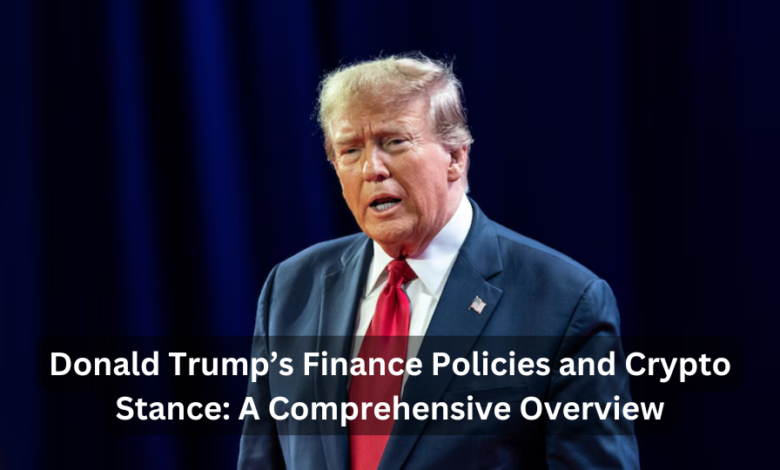Donald Trump’s Finance Policies and Crypto Stance: A Comprehensive Overview

As we navigate the evolving financial landscape of the United States, one name that consistently captures attention is Donald Trump. His policies, opinions, and influence on finance and cryptocurrencies continue to shape discussions, particularly as his public stances often deviate from conventional expectations. In this article, we will delve deeply into Trump’s finance policies and his crypto stance, offering an extensive analysis that not only reflects his actions during his presidency but also explores how these policies have evolved since then.
Trump’s Fiscal Policies During His Presidency
Tax Reform: The Tax Cuts and Jobs Act (TCJA)
One of Donald Trump’s most significant financial legacies is the Tax Cuts and Jobs Act (TCJA), signed into law in 2017. The TCJA aimed to reduce corporate taxes, slash individual rates, and simplify tax brackets. The act lowered the corporate tax rate from 35% to 21%, marking one of the largest tax cuts in U.S. history. By reducing taxes, Trump’s administration aimed to stimulate economic growth, increase business investments, and improve consumer spending.
However, while the TCJA brought short-term economic gains, it also increased the federal deficit substantially. Critics argue that the act primarily benefited corporations and the wealthy, further widening the income inequality gap. Supporters, on the other hand, emphasize the economic boom that followed, citing low unemployment rates and record-breaking stock market performance. In reality, while the immediate benefits were clear, the long-term fiscal consequences of such a tax policy remain hotly debated.
Deregulation: A Business-Friendly Approach
Trump’s administration was known for its commitment to deregulation, especially in the financial and environmental sectors. His approach focused on reducing government oversight to foster business growth and innovation. Trump rolled back key Dodd-Frank regulations, particularly those imposed on small and medium-sized banks. This move aimed to ease the operational challenges these banks faced, promoting lending and credit availability to businesses and consumers alike.
While deregulation helped revitalize industries, it also raised concerns about the potential risks of financial instability. Critics argue that reducing oversight in critical sectors may create vulnerabilities similar to those witnessed during the 2008 financial crisis.
Trade Policies: America First
Trump’s trade policies were driven by his “America First” ideology, which translated into a mix of protectionism and tariffs aimed at reducing the trade deficit with other nations. His most notable move was the trade war with China, where he imposed billions of dollars worth of tariffs on Chinese goods. Trump argued that such tariffs would protect American jobs and industries, particularly in manufacturing.
The trade war did lead to a renegotiation of several key trade deals, including the United States-Mexico-Canada Agreement (USMCA), which replaced the North American Free Trade Agreement (NAFTA). However, the tariffs also had unintended consequences, particularly for American farmers and consumers, who faced rising prices on goods.
National Debt and Federal Spending
One area where Trump’s financial policies garnered criticism was the sharp rise in the national debt. During his tenure, the U.S. national debt increased by over $7 trillion, reaching record levels. While tax cuts and increased military spending contributed to this surge, the COVID-19 pandemic in 2020 further exacerbated the situation. The administration’s stimulus efforts, including the $2 trillion CARES Act, were essential to combating the economic fallout of the pandemic, but they came at the cost of long-term fiscal health.
Trump’s Stance on Cryptocurrencies: Skepticism and Criticism
Early Comments: Bitcoin as a “Scam”
Donald Trump’s crypto stance has been clear from the start. In 2019, Trump tweeted his concerns about Bitcoin and other cryptocurrencies, labeling them as “highly volatile” and based on “thin air.” He expressed doubts about their legitimacy as a currency and warned that they could facilitate illegal activities like money laundering and fraud. Trump’s administration, particularly under Treasury Secretary Steven Mnuchin, echoed these sentiments, taking a cautious approach toward the growing crypto market.
Trump’s skepticism toward cryptocurrencies aligns with his preference for traditional financial systems. He has consistently promoted the U.S. dollar as the world’s reserve currency, and any perceived threats to this dominance—whether from crypto or digital currencies like Facebook’s Libra—were met with firm opposition.
Regulatory Measures: Crypto Under Scrutiny
During Trump’s presidency, several regulatory actions were taken to keep the crypto market in check. The Financial Crimes Enforcement Network (FinCEN) introduced proposals aimed at increasing transparency in crypto transactions. The administration also focused on combating the use of cryptocurrencies in illegal activities, with Mnuchin stating that they posed a “national security issue.”
Moreover, crypto exchanges and companies operating in the U.S. had to navigate an increasingly complex regulatory environment. The Securities and Exchange Commission (SEC) took a more aggressive stance toward initial coin offerings (ICOs), many of which were deemed unregistered securities. While the crypto market continued to grow, the regulatory pressures ensured that it did so under tighter scrutiny.
Trump’s Post-Presidency Views on Cryptocurrency
Since leaving office, Trump has continued to voice his disapproval of cryptocurrencies. In an interview in June 2021, he reiterated his belief that Bitcoin was a “scam” and expressed concerns about its potential to harm the U.S. dollar. Despite the growing acceptance of cryptocurrencies in mainstream financial markets, Trump’s stance remains largely unchanged. He continues to advocate for a strong U.S. dollar and has been critical of the Federal Reserve’s policies on digital currencies.
The Rise of Central Bank Digital Currencies (CBDCs)
In the broader context of Trump’s opposition to cryptocurrencies, the rise of Central Bank Digital Currencies (CBDCs) presents an interesting dynamic. While Trump has yet to make definitive statements about CBDCs, his emphasis on maintaining the U.S. dollar’s supremacy suggests that he would be more supportive of a CBDC issued by the Federal Reserve than of decentralized cryptocurrencies like Bitcoin.
Countries like China have made significant progress with their digital yuan, raising concerns about the future of global currency dominance. Trump’s focus on maintaining U.S. leadership in the global financial system may push his support toward government-backed digital currencies rather than decentralized alternatives.
The Global Impact of Trump’s Finance Policies and Crypto Stance
Global Market Reactions
Trump’s financial policies, particularly his tax reforms and trade wars, had far-reaching consequences for global markets. While the U.S. economy initially flourished under his tax cuts, the trade tensions with China and other countries led to market volatility. Global investors remained cautious, with many industries—especially automotive and technology—caught in the crossfire of tariffs and retaliatory actions.
Trump’s crypto stance also reverberated through the global financial system. As the leader of the world’s largest economy, his criticisms of cryptocurrencies often led to short-term fluctuations in the value of Bitcoin and other digital assets. His administration’s regulatory measures added further scrutiny to the global crypto market, affecting not just U.S.-based companies but also international crypto exchanges and investors.
U.S.-China Economic Tensions and Cryptocurrency
The ongoing U.S.-China economic tensions that defined Trump’s presidency also had implications for the crypto space. As China moved aggressively to digitize its economy, launching its own central bank digital currency (CBDC), the U.S. lagged behind in developing a cohesive crypto policy. Trump’s hesitance toward cryptocurrencies, coupled with his focus on trade wars, arguably slowed down U.S. innovation in the digital currency space.
China’s advancements in blockchain technology and the digital yuan pose a potential challenge to the global dominance of the U.S. dollar. While Trump’s administration acknowledged the national security risks associated with decentralized currencies, it lacked a comprehensive strategy to counter China’s rapid progress in the CBDC arena.
Cryptocurrency Regulations: What the Future Holds Post-Trump
The Biden Administration’s Approach
Since Trump’s departure from office, the Biden administration has adopted a more nuanced stance toward cryptocurrencies. With the appointment of Gary Gensler as the head of the SEC, there has been a greater emphasis on regulating the crypto market while ensuring that innovation is not stifled. This represents a shift from Trump’s largely dismissive approach to one that seeks to balance regulation and growth.
Nevertheless, Trump’s influence on crypto regulation continues to be felt. His policies set the foundation for the current regulatory environment, which remains cautious of crypto’s impact on the traditional financial system.
The Role of the U.S. Dollar and Global Financial Stability
One of the central tenets of Trump’s financial philosophy was the protection of the U.S. dollar’s role as the global reserve currency. In a world where cryptocurrencies and digital assets are gaining traction, this stance becomes even more relevant. The rise of Bitcoin and other decentralized currencies represents a potential threat to U.S. financial hegemony.
Trump’s refusal to embrace cryptocurrencies can be viewed as a broader effort to safeguard the existing financial order, one in which the U.S. dollar plays a pivotal role. However, as crypto adoption continues to grow, future administrations will need to strike a balance between innovation and maintaining financial stability.
Conclusion
In summary, Donald Trump’s approach to finance and cryptocurrency reflects a traditional, pro-business stance with a clear emphasis on protecting U.S. interests. His policies—ranging from tax cuts and deregulation to his firm opposition to cryptocurrencies—have left a lasting impact on the financial landscape. As the world of finance continues to evolve, the implications of Trump’s presidency will be analyzed for years to come, particularly as cryptocurrencies gain more prominence and the global financial order faces unprecedented challenges.
For businesses and investors, it remains essential to stay informed about the regulatory landscape and the potential long-term effects of policies that continue to shape the financial world, particularly in the burgeoning space of cryptocurrency. As the U.S. grapples with the future of digital currencies, the enduring influence of Trump’s policies will play a critical role in determining the direction of financial innovation and economic stability.




